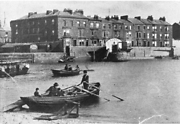 Hartlepool Sports & Leisure
Hartlepool Sports & Leisure
- Cinemas, Theatres & Dance Halls
- Musicians & Bands
- At the Seaside
- Parks & Gardens
- Caravans & Camping
- Sport
 Hartlepool Transport
Hartlepool Transport
- Airfields & Aircraft
- Railways
- Buses & Commercial Vehicles
- Cars & Motorbikes
- The Ferry
- Horse drawn vehicles
 A Potted History Of Hartlepool
A Potted History Of Hartlepool
- Unidentified images
- Sources of information
- Archaeology & Ancient History
- Local Government
- Printed Notices & Papers
- Aerial Photographs
- Events, Visitors & VIPs
 Hartlepool Trade & Industry
Hartlepool Trade & Industry
- Trade Fairs
- Local businesses
- Iron & Steel
- Shops & Shopping
- Fishing industry
- Farming & Rural Landscape
- Pubs, Clubs & Hotels
 Hartlepool Health & Education
Hartlepool Health & Education
- Schools & Colleges
- Hospitals & Workhouses
- Public Health & Utilities
- Ambulance Service
- Police Services
- Fire Services
 Hartlepool People
Hartlepool People
 Hartlepool Places
Hartlepool Places
 Hartlepool at War
Hartlepool at War
 Hartlepool Ships & Shipping
Hartlepool Ships & Shipping

Ferry boats and people
Details about Ferry Boats And People
For centuries the Ferry was the quickest way to travel between the Headland and Middleton. The earliest written record of a ferry at Hartlepool dates back to 1600. At its peak it carried thousands of workers to the shipyards at Middleton.
In 1918, Hartlepool Corporation bought the ferry rights from the Hartlepool Ferry & Harbour Company for £500.
It finally closed in the 1950s, when more convenient ways of travelling made it redundant.
Location
Related items :
 Aerial view of Southgate
Aerial view of Southgate
 Donated by Hartlepool Museum Service
Donated by Hartlepool Museum ServiceHartlepool Ferry is on the centre right. On the skyline, from left to right is the spire of St. Mary's Church, St. Hilda's Church tower and the Borough Hall building.
HHT+N 626
More detail » Almost there
Almost there
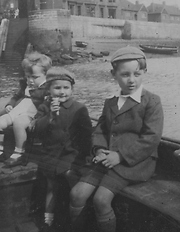 Donated by June Percival
Donated by June PercivalThe Middleton Ferry approaching the Headland landing steps with the Stoddart children (from left to right), Charlie (aged 1½), June (aged 3), and Gerorge (aged 6).
More detail » Bye Laws relating to Hartlepool Ferry, 1851
Bye Laws relating to Hartlepool Ferry, 1851
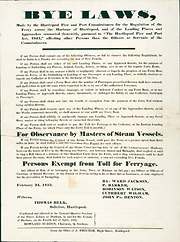 Created by J. Procter
Donated by Hartlepool Library Service
Created by J. Procter
Donated by Hartlepool Library ServiceBye Laws relating to Hartlepool Ferry 1851.
More detail » Dentons Shipyard c1860 (2)
Dentons Shipyard c1860 (2)
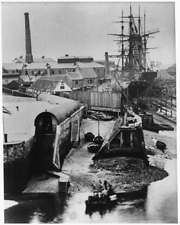 Part of the Hartlepool Library Services collection
Part of the Hartlepool Library Services collectionA detailed picture with a sailing ship being built/repaired. Middleton ferry in the foreground.
More detail » Extra crew
Extra crew
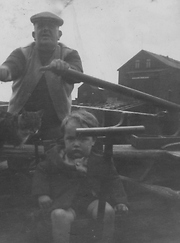 Donated by June Percival
Donated by June PercivalA young Charles Stoddart, on the ferry across to Middleton, is being carefully watched by the ship's cat. In the background is the Lifeboat Station.
More detail » Ferry Landing stage
Ferry Landing stage
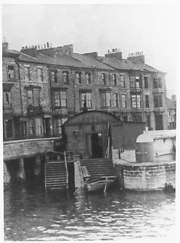 Donated by Douglas Ferriday
Donated by Douglas FerridayPart of the Hartlepool Library Service collection
Dated 1900
 Ferry Steps (1)
Ferry Steps (1)
 Created by NAS NE
Donated by NAS NE
Created by NAS NE
Donated by NAS NEDated 2012
The Ferry steps; in the background is the Pilots Pier (top left), and the 'Banjo' Pier (top right). 2012.
More detail » Ferry Steps (2)
Ferry Steps (2)
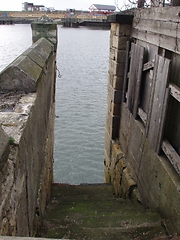 Created by NAS NE
Donated by NAS NE
Created by NAS NE
Donated by NAS NEDated 2012
Looking down another set of Ferry steps at old Hartlepool. In the distance (on the Middleton side), is the current Lifeboat Station. 2012.
More detail » Ferry setting off
Ferry setting off
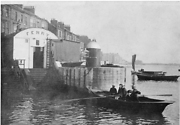 Donated by Hartlepool Museum Service
Donated by Hartlepool Museum ServiceFerry setting off from old Hartlepool with passengers.
More detail » Ferry steps from Middleton
Ferry steps from Middleton
 Donated by Hartlepool Museum Service
Donated by Hartlepool Museum ServicePhoto taken from a point just north of a middleton ferry landing. Town Wall buildings at right. Fish Quay buildings at left. Headland ferry steps at right.
HHT&N 792
More detail » Frank Andrews
Frank Andrews
 Created by unknown
Donated by Lynn Gowland
Created by unknown
Donated by Lynn GowlandFrank "Pipes" Andrews with a group of family members in his ferryboat.
More detail » Hartlepool Ferry
Hartlepool Ferry
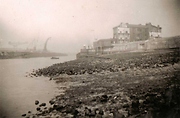 Donated by Rosa Simon
Donated by Rosa SimonDated 1949
A view of the Hartlepool (Middleton) Ferry taken in 1949. In the backround are the town's iconic swan-neck and hammer-head cranes.
More detail » Hartlepool Ferry
Hartlepool Ferry
 Donated by Mike Oxley
Donated by Mike OxleyPicture of the ferry from Old Hartlepool to Middleton taken from a postcard around 100 years old.
More detail » Hartlepool Ferry
Hartlepool Ferry
 Donated by Mike Oxley
Donated by Mike OxleyPicture of the ferry from Old Hartlepool to Middleton taken from a postcard around 100 years old.
HHT&N 642
More detail » Hartlepool Ferry
Hartlepool Ferry
 Donated by Mike Oxley
Donated by Mike OxleyPicture of the ferry from Old Hartlepool to Middleton taken from a postcard around 100 years old.
More detail » Hartlepool Ferry
Hartlepool Ferry
 Donated by Mike Oxley
Donated by Mike OxleyPicture of the ferry from Old Hartlepool to Middleton taken from a postcard around 100 years old.
More detail » Hartlepool Ferry (2)
Hartlepool Ferry (2)
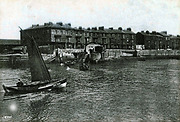 Donated by Hartlepool Library Service
Donated by Hartlepool Library ServiceThe 'old' Hartlepool Ferry landing.
More detail » Hartlepool Ferry - 1890
Hartlepool Ferry - 1890
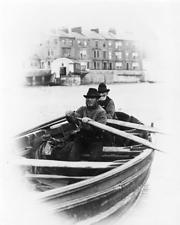 Created by James Whitehead Pattison
Donated by Bowes Museum, Barnard Castle, County Durham
Created by James Whitehead Pattison
Donated by Bowes Museum, Barnard Castle, County DurhamPart of the Pattison's Photographs collection
Dated 1890
The ferryman rows a gentleman to the terminal in 1890.
More detail » Hartlepool Ferry 1853, For Regulating the Working of the Boatment (sic)
Hartlepool Ferry 1853, For Regulating the Working of the Boatment (sic)
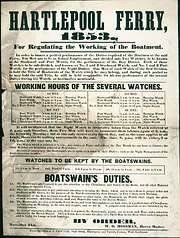 Created by J. Procter
Donated by Hartlepool Library Service
Created by J. Procter
Donated by Hartlepool Library ServiceHartlepool Ferry 1853, For Regulating the Working of the Boatment (sic)
More detail » Hartlepool Ferry Terminal - c1890
Hartlepool Ferry Terminal - c1890
 Donated by Maureen Anderson
Donated by Maureen AndersonA busy day for the rowing boats as they ferry their passengers to and fro.
More detail » Hartlepool Ferry rush hour 1930
Hartlepool Ferry rush hour 1930
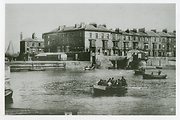 Donated by Douglas Ferriday
Donated by Douglas FerridayPart of the Hartlepool Library Service collection
 Hartlepool Ferry terminal
Hartlepool Ferry terminal
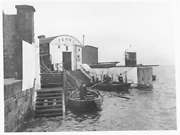 Donated by Douglas Ferriday
Donated by Douglas FerridayPart of the Hartlepool Library Service collection
People have just got onto the ferry and about to set off to the other side. Another ferry waiting to replace the departing one.
More detail » Hartlepool Ferry, application sfor employment notice, 1853
Hartlepool Ferry, application sfor employment notice, 1853
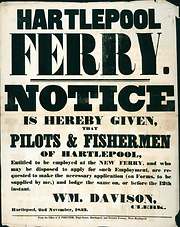 Created by J. Procter
Donated by Hartlepool Library Service
Created by J. Procter
Donated by Hartlepool Library ServiceHartlepool Ferry, application sfor employment notice, 1853.
More detail » Ice-cream on the boat
Ice-cream on the boat
 Donated by June Percival
Donated by June PercivalA very smartly dressed June Stoddart enjoying an ice-cream on a ferry journey back to the Headland. The ferry landing can be seen on the extreme left of the picture.
More detail » Middleton to old Hartlepool ferry
Middleton to old Hartlepool ferry
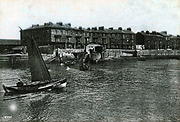 Donated by Hartlepool Library Service
Donated by Hartlepool Library ServiceThe Middleton to Hartlepool Ferry looking from the Middleton side. All the houses are now long gone
More detail » Ship-shape
Ship-shape
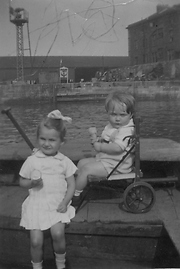 Donated by June Percival
Donated by June PercivalJune and Charlie Stoddart enjoying ice-creams on the Middleton ferry.
More detail » The Ferry
The Ferry
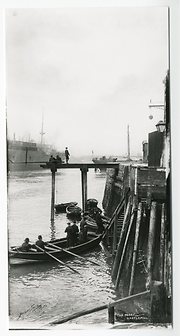 Donated by Hartlepool Library Service
Donated by Hartlepool Library ServiceAn unusual view of the Hartlepool to Middleton Ferry. The steps are not the ones we normally associate with it. The men on the end of the jetty seem to be fending something off with a pole whilst those in the boat are looking in that direction.
More detail » The Ferry
The Ferry
 Donated by Hartlepool Library Service
Donated by Hartlepool Library ServiceA nice clear picture of the Ferry and the house behind.
More detail » The Ferry
The Ferry
 Donated by Hartlepool Library Service
Donated by Hartlepool Library ServiceThe Ferry entrance at Southgate. man in straw boater getting on with a bicycle. I wonder what the fare for that was?
More detail » The Ferry - a short history
The Ferry - a short history
HARTLEPOOL FERRY
The old town of Hartlepool, on the north-east coast of England, is built on a spur of land which is connected to the mainland by a narrow causeway. For centuries an important means of local transport was the ferry. It was the quickest way to travel between the Headland and the mainland. At its peak it carried thousands of workers to the shipyards at Middleton. It finally closed in the 1950s, when more convenient ways of travelling made it redundant.
Hartlepool ferry transported its passengers from the Headland to Middleton, West Hartlepool. The map shows how useful the ferry was. The route by land went around the marshy area known as the ‘Slake’. The ferry saved travellers a walk of at least a mile (1.6 km). The distance across the water was less than 100 m (109 yards).
The ferry existed for several hundred years before West Hartlepool was built. A written record, dated 1600, reports that money was paid to William Porrett for providing a “fferriboote”. In early times this connected the Headland with the old coast road, which went along the sands to the nearby town of Stockton.
Looking forward to retirement?
In the early 19th century the ferry was operated by former local fishermen, who were paid by Hartlepool Corporation. Richmond’s ‘Local Records of Stockton and Neighbourhood’ (published in 1868) describes them as “decayed or infirm fishermen and pilots”. This means that they had become too old or frail to work on the fishing boats.
A new ferry was started by the Harbour Commissioners in 1852 to connect Hartlepool Headland with the new and rapidly growing West Hartlepool. They spent a large amount of money on new boats, uniforms for the boat crew, and building new landing stages. The boats were built by the local firm of Pounders and could carry up to sixty passengers. They were crewed by two men, or four in bad weather.
For many years the two ferry services ran side by side. There was some rivalry between them, but the support of the local people ensured that the fishermen’s ferry kept at least as many customers as the grander new ferry. The original ‘Old Ferry’ ran north-east to south-west across the harbour. The ‘New Ferry’, ran east to west. The routes met in the middle, and since the boats carried no lights, night-time collisions with each other, or larger vessels, were always a possibility!
Bringing the men to work
The ferries became very important in the mid 19thcentury when the docks were built, as they brought workmen from the Headland to the Middleton shipyards and engineering works. During World War I, when the yards were building warships, they carried over a thousand men a day. The demand became so great that the two services together couldn’t cope. The Harbour Commissioners decided to return the running of their ferry to the Corporation in 1918.
Events turn full circle.
Although the ferry had been popular it was very expensive to run and began to lose money. The boats were open to the weather. As safer and warmer ways of travel became available demand for the ferry fell off. In 1939 the Corporation handed their boats over to the fishermen. The fishermen closed their own service and continued running the new ferry. It finally closed in 1952. The last ferryman was Thomas Boagey, who died, falling down the ferry steps. This was the end of a centuries old tradition of fishermen taking passengers across Hartlepool Bay.
More detail » Town Wall from Middleton
Town Wall from Middleton
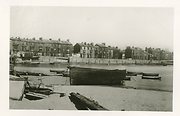 Donated by Hartlepool Museum Service
Donated by Hartlepool Museum ServiceTaken from Middleton showing town wall & the Ferry on the left. Spine of St. Mary's to right of centre and St. Hilda's on left
More detail » Unknown woman on Hartlepool Ferry
Unknown woman on Hartlepool Ferry
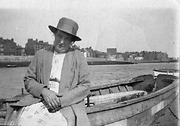 Donated by John Dee
Donated by John DeeUnknown woman on Ferry which ran between Old Hartlepool and Middleton.
More detail » Walter Watkins
Walter Watkins
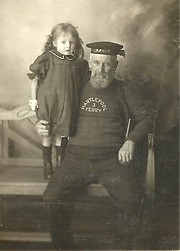 Donated by Malcolm Hardy
Donated by Malcolm HardyThis photograph shows Ferryman Walter Watkins with his granddaughter Josephine Navy Carling.
More detail »




